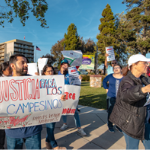Desired for their labor, rejected as neighbors. Farmworkers in California face hostile communities
.jpg)
The “urban farm homes” nestled along a cul-de-sac off an old farm road in Nipomo, Calif., had lofted floor plans with more than 2,500 square feet of living space — “perfect … for multi-generational living,” the advertisements boasted.
Strawberry grower Greg France and his wife, Donna, had other ideas for the planned seven-home development. They would use it to host more than 100 workers coming up from Mexico to pick strawberries on their farms under an agricultural guest worker program.
When neighbors in the southern San Luis Obispo County town of 17,000 saw bunks being moved into one of the newly constructed houses, anger erupted. Meetings were held, fingers were pointed and death threats were hurled at the Frances.
On April 6, 2016, flames devoured one of the unfinished homes, not yet wired for electricity. Investigators almost immediately concluded it was arson.
The case remains unsolved. So does the housing problem for temporary guest workers in towns and cities along California’s coastal agricultural belt.
Increasingly fond of locally grown produce, Californians are far less enthusiastic about locally housed farmworkers. They have deployed lawsuits, hastily written regulations — and, apparently, the torch — to segregate thousands of seasonal workers to seedy roadside hotels and crowded housing in cities where affordable shelter is already limited.
“They love the strawberries, but they don’t like the farmworkers,” said Lucas Zucker, policy and communication director for Central Coast Alliance United for a Sustainable Economy, a labor advocacy group in Ventura.
That age-old “not in my backyard” reaction threatens growers’ ability to fill the current labor shortage and exacerbates the long-term housing crisis for local farmworkers.
Last year, California recruited more than 11,000 guest workers, largely to pick strawberries or cut lettuce, according to a Los Angeles Times analysis of Department of Labor data. Recruitment in the first four months of this year is up 25% over a similar period last year.
All of those guest workers have to be housed by their employers, at no charge to the worker, under the visa program known as H-2A.
More than 1,400 of those guest workers have squeezed into the Central Coast city of Santa Maria, where 1 in 5 residents already live below the poverty level. An additional 2,500 are staying in the impoverished cities of the Salinas Valley, according to federal records.
Only 12 are living in the residential center of Nipomo, where France is selling the last of his houses. This season, his contracted guest workers will bunk in Santa Maria.
“We’ve learned our lesson,” France said. “We need to be sure they’re in a suitable area, both for them and their neighbors.”
An old sugar mill site in the Salinas Valley seemed like a suitable place to house as many as 800 guest workers for Tanimura & Antle Produce.
The company’s workers traditionally harvested lettuce and vegetables in the Imperial Valley in winter, moved to the Central Valley in early spring, then to the Salinas Valley. But that migration has waned as housing in Salinas became more expensive — the 156,000 residents of the city pay more of their income for shelter than most people in California, making it one of the state’s least affordable places to live.
Tanimura & Antle struggled to find enough laborers to harvest its Salinas Valley crops — $2 million in lettuce was left to rot in 2015.
The company drew up plans to house Mexican guest workers at Spreckels Crossing, a 4.5-acre campus of eight buildings set amid athletic fields, a barbecue area and recreation hall. Workers would get to and from fields by company bus and take public transit to Salinas, three miles north.
Affordable housing advocates and county planners loved it. The town of Spreckels did not.
Spreckels’ 760 residents — nearly all white, native born and earning well above the state’s median income — feared that migrant workers would bring crime and traffic and destroy property values. Several filed suit to slow the project. The school district insisted on a $330,000 fee to build new schools — later reduced — even though the guest workers, predominantly male, would be leaving their children in Mexico.
Some residents suggested that a labor camp didn’t fit with the town’s historic character — even though historians consider it to be one of the best-preserved “company towns” in America, built by sugar baron Claus Spreckels for a succession of immigrant mill workers from Germany, Japan and Mexico.
No foreign guest workers moved in when Spreckels Crossing opened last summer. Tanimura & Antle had advertised the guest worker jobs — as required by the U.S. Department of Labor — and the company’s U.S.-based workers leaped at the chance to pay about $125 a month to share a brand-new two-bedroom suite with as many as seven other workers.
Rick Antle, the company’s chief executive, says he hopes that Spreckels Crossing “never fills up” with guest workers — he’d rather win the competition for local laborers by offering better housing, higher wages and an employee stock ownership plan.
“The H-2A [program] is not the answer, guys,” Antle said. “As much as you hear people saying that’s the solution, it’s not. That worker is taking his earnings and he’s exporting them to Mexico. He’s not spending them locally.”
But Tanimura & Antle still relies on hundreds of guest workers for its winter fields near the Mexican border — 750 were approved this year, according to federal data.
“Hopefully we will be able to eliminate that,” Antle said.
Affordable housing advocates and planning officials say if more growers imitate the Spreckels Crossing project, they could put to rest fears of reviving the post-World War II “bracero” era, when Mexican workers lived in squalid barracks.
“It’s beautiful — I would put family in there,” said Alfred Diaz-Infante, president and CEO of CHISPA, a private, nonprofit, affordable housing developer in Salinas. “That’s something we’re advocating for. We know what happened in the bracero era, where they built bunkhouses and over the years they became worker housing.”
Before she started sharing a two-bedroom suite with five other women, Dora Jan, a lettuce packer, followed the crop from Yuma, Ariz., shelling out more than $300 a month for a tiny room in a house in one of Salinas’ worst neighborhoods. She often had no hot water, no access to a kitchen and no contract. After one eviction, she spent several weeks sleeping in a car.
“You really had to fight, just to keep a room in a house with a family,” Jan said.
Now she and her five suite mates often wake two hours before their 7 a.m. shift, just to sit around the kitchen table, drink coffee and talk. “We’re in our glory,” roommate Lucia Jaquez said.
The problem is that no one has been able to duplicate the Spreckels Crossing model in the areas that need it the most.
Two years ago, Bonipak Produce drew up a similar proposal to house 600 workers in a bunkhouse complex outside Santa Maria. They took it to the Santa Barbara County Planning Commission, hoping for approval in time to start construction by August.
It still has not been built.
Glenn Russell, the county’s director of planning and development, says the county quickly endorsed the construction project. But federal officials have held it up over potential harm to the tiger salamander.
“They asked if we could move heaven and Earth and we moved heaven and Earth,” Russell said. “Then they ran smack dab into an endangered species issue.”
Instead, Bonipak’s workers are living in a renovated former Budget Inn on Santa Maria’s north end, which the company purchased with partners for $1.5 million in 2015.
Displaced residents of those hotels, however, still have to find other places to live. And increasingly, those places are also being used for guest workers — including at least two dozen single-family homes and apartment complexes. One six-bedroom home will house 30, while 20 others will share a three-bedroom house, according to Labor Department records.
Although employers appear to be complying with federal rules that require 50 square feet of sleeping space and 100 square feet of living space per worker, that’s not what most cities have in mind for adequate housing.
“It’s not just H-2A,” Santa Maria Deputy City Manager Jason Stilwell said. “It’s like that in every city. A lot of houses are overcrowded.”
Each city is taking a slightly different approach. In Salinas, officials worry less about hotels and more about inspecting the homes of permanent residents — H-2A housing at least is inspected annually by the state, they say.
“We really have not dug into it, because we can’t keep up with our own issues,” said Megan Hunter, director of community development for Salinas. “We’re not turning a blind eye, but we’re not going after people who are otherwise safely housed.”
In King City, where at least 235 guest workers are staying in four hotels, city officials allowed labor contractors to convert a former tomato cannery into temporary housing. One grower is eyeing the site of a former labor camp, City Manager Steven Adams said.
Not all small cities have been as accommodating.
Guadalupe, in Santa Barbara County, hastily passed an ordinance regulating worker housing after word got around that a labor contractor was looking to buy an apartment building there. The deal fell through.
On a 150-acre strawberry farm a few miles northwest of that town, Greg France recently watched local workers scurry down furrows, filling carton after carton with lush red berries. If they kept up the pace, their per-carton salary would soar to twice the guaranteed state minimum of $10.50 per hour — one worker set a record at $36, France said.
That kind of hustle is getting rarer as the local workforce gets older and slower, France said.
Younger, more energetic guest workers can pick up the slack, but hiring them through contractors is not cheap, France said. The federal hourly rate for H-2A workers in California is $12.57, and contractors add a premium to that to cover overhead, including housing and meals, he said.
France said next season he might try to hire workers directly and find housing for them — just not in Nipomo.
“We’re just going to hope we can do it right and not get into trouble,” he said. “We would try to secure housing in Santa Maria.”
That won’t be easy. Santa Maria has plans for about 1,818 affordable housing units. And besides Bonipak, no other grower has proposed to build farmworker housing in the valley.
California’s seasonal guests will once again come and go, unnoticed but for the muddy boots they leave outside hotel doors.
That anonymity has marked them for decades. In 1936, a photographer stopped at a pea picker camp along U.S. 101 north of Santa Maria, where she found dozens of starving migrant workers.
Dorothea Lange took a picture of a mother, her thin hand worrying her lips, an infant on her lap, a child leaning on each shoulder. The haunting image sparked a federal effort to ease the suffering of California’s seasonal farmworkers.
She was less than a mile from where Greg France’s urban farm home would be burned to the ground 80 years later.
Times Data Editor Ben Welsh contributed data analysis to this report.














